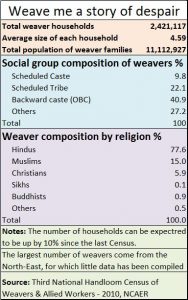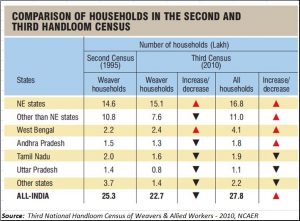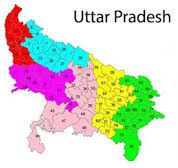http://www.firstpost.com/business/demonetisation-with-polls-round-the-corner-budget-may-have-a-few-sops-for-devastated-weavers-3202900.html
Budget proposals that could swing voter sentiment – III ; Weaving a picture of devastation
(With elections being announced for many states, including Uttar Pradesh, many believe that the budget to be announced on 1 February, will contain sops for key sectors. There are two reasons for such sops. First, to counter the unfortunate effects of demonetisation on some sectors. And the second to win over key electoral groups. In this three part series, we explain why the three biggest segments that might benefit could be agriculture, milk cooperatives and milk processing units, and weaver units. This is the last of the series)
Of all the communities hit by demonetisation, none has been hit as badly as the weaver community. This is true of the handloom sector as well as the powerloom sector. Weaver towns look almost ghostly, with most of the weaving units shut. And since most workers are daily wage earners, they have been thrown out without any safety net, except the assurance from the owners that they will be called back once the situation improves.
In Bhiwandi, there are tales about how weavers and process house owners were paid their last dues in Rs.500 and Rs.1,000 notes. The justification: “When we negotiated rates, we had this currency in mind. Now you go and exchange it”. Both process house owners and workers had to wait in queues in order to convert their currency into legal tender.
Tirpur in South India is also a ghost town. So is Varanasi where around a lakh weavers – who weave the famous Banarasi sarees – are out of job. The plight of Varanasi weavers has been covered by much of media (https://www.thequint.com/currency-ban/2016/12/23/from-silk-weavers-to-boatmen-poor-hit-hard-by-demo-in-modis-varanasi-narendra-modi-demonetisation-currency-ban)
 One source talks of Lallapur which is home to some of the most skilled Muslim weavers and known for producing the city’s best silk sarees and furnishings.
One source talks of Lallapur which is home to some of the most skilled Muslim weavers and known for producing the city’s best silk sarees and furnishings.
Reports talk of how the number of weavers had already plunged to 40,000 in 2015 from over 300,000 a few years ago. Many blame this exodus on communal tensions, but this hasn’t been verified or documented. The post-demonetisation crisis will force skilled artisans and jobless weavers to abandon their profession and look for other work.
A similarly painful situation exists in Surat as well – where both the diamond cutting trade and the powerloom sectors have been hit.
A large number of weavers are located in the North-East. But typical of most government data, breakup of economic information about the states in the North East is almost entirely absent. In fact, this is also true for illegal mining, where even though huge black money is made from illegal mining, no data is available from the North East (http://www.asiaconverge.com/2016/08/illegal-mining-thrives-even-today/).
 Politicians would have ignored the unemployed and the dispossessed as another instance of collateral damage, but for two factors. First, the numbers involved are very large. Data available from the Thrid National Handloom Census of Weavers and Allied Workers – 2010 throws up some interesting numbers.
Politicians would have ignored the unemployed and the dispossessed as another instance of collateral damage, but for two factors. First, the numbers involved are very large. Data available from the Thrid National Handloom Census of Weavers and Allied Workers – 2010 throws up some interesting numbers.
There are 24 lakh weaver households. Each household comprises approximately 4.59 people in statistical terms. That gives you a total weaver population of 1.11 crore people who are affected. Add to this the population of powerloom weavers – the number could be around 5 lakh households or 20 lakh people – and you have a figure of 1.3 crore people. This is too large a number to be ignored.
If you take the textile and apparel sector together, they are reported to have accounted for almost 51 million workers in 2015-16, The powerloom sector employed almost 65 lakh people. Multiply these numbers by 4 and you have a good idea of the number of people who have been adversely affected.
The second factor is that almost 73% of this number is from backward classes (see chart). This is a very important electoral group, especially in UP.
Slice the number further and you find that 15% of the total number comprises Muslims, which is another crucially significant electoral group – especially in Uttar Pradesh.
With elections being announced in UP and the North East, the weaver community suddenly becomes a critical focal group.
That is why, many analysts believe that the biggest sops in the budget might go towards helping re-settle weaver units. How these sops will be announced is anyone’s guess. But given the volatile combination of backward classes and Muslims, no government can afford to ignore this crucially important segment. It may be recalled how during the last general elections, even the ruling Congress wanted to announce loan waivers for the weavers of UP.
As mentioned in the second part of this series, the same will apply to the milk industry – which today accounts for a large number of Muslims – at least in Western and Southern India. Anecdotal evidence points to how many Hindus opted to abandon the milk industry in these territories during the 1950s and 1960s. That was when religious pressure groups began talking about how the gods would be upset if farmers sold their cows to traders after they stopped lactating (http://www.asiaconverge.com/2015/11/who-killed-the-holy-cow/). Except for some part of Gujarat – notably Anand – most Hindus became squeamish about owning cows. Within a couple of decades, the cattle trade moved to the Muslims. Since they were now owners of cattle, it was natural that they would also consolidate their hold on the veterinary trade. Today, both the cattle and veterinary trades in West India is dominated by Muslims, much to the chagrin of Hindus.
Moreover, the Hindus and the backward classes are also actively involved in skinning carcasses and selling meat.
But given the BJP’s discomfort towards appeasing slaughter houses and tanneries, it is not certain if any sops will be offered, or whether idealogy will be replaced by political calculations. Sops for the milk industry will therefore remain a big uncertainty.
But incentives for forming milk cooperatives may be given a big push.
Expect concessions for agricultural produce processing and storage units.
In other words, the current budget proposals might have sops for agriculture, milk cooperatives and for weavers. Since these sops extend to the entire country, nobody will be able to claim that they are targeted at states which go to the hustings. Moreover, given the urgent national priority to improve child nutrition and to augment agricultural income, nobody can allege a partisan approach if agriculture and milk cooperatives are given a boost.
That could explain why the opposition is crying hoarse for the budget to be postponed. The Supreme Court has refused to intervene. Now it is up to the Election Commission.
The three part series ends here.
The other two parts can be found at
http://www.asiaconverge.com/2017/01/uttar-pradesh-elections-budget-2017-and-milk-leather/
and
http://www.asiaconverge.com/2017/01/budget-2017-uttar-pradesh-elections-and-agriculture/
Budget 2017: With polls nearing, will Uttar Pradesh’s farm sector, industry get a boost?



































COMMENTS